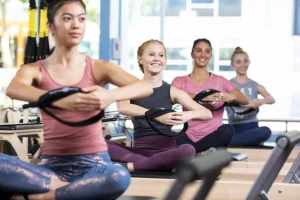Let’s be honest. The digital nomad life looks incredible on Instagram. Laptop on a beach? Coffee shop in Prague? It’s the dream. But the reality often involves a different kind of post—the dreaded “programmer’s hunch” from hours on a tiny cafe chair, or the slow creep of what I call “nomad weight” from inconsistent meals and zero routine.
Fitness for remote workers isn’t just about looking good. It’s the anchor. It’s the one non-negotiable habit that keeps your energy stable, your mind clear, and your back from staging a full-blown rebellion. So, how do you build a sustainable fitness routine when your office is a moving target? Let’s dive in.
The Remote Worker’s Body: More Than Just a Sedentary Statistic
You’ve felt it. That 3 PM fog after a long morning of video calls. The stiff hips after a cross-continental flight. Our bodies weren’t designed for this. The science is clear: prolonged sitting is the new smoking, linked to everything from cardiovascular issues to skyrocketing stress levels.
For digital nomads, the challenges are even more… specific.
- The “I’m Always Traveling” Excuse: Your gym membership back home is useless. Equipment is a fantasy.
- Ergonomic Nightmares: Your workspace is a bed, a couch, or a wobbly patio table.
- Decision Fatigue: Figuring out where to workout in a new city every week is mentally exhausting.
The good news? You don’t need a gym. You just need a system.
Building Your No-Equipment, Anywhere Fitness Plan
Forget the heavy weights for a second. The most powerful tool you have is your own body. Bodyweight training is brutally effective, incredibly versatile, and it fits in your backpack. Here’s a simple framework to get you started.
The Foundational Movement Patterns
Think of your body in terms of movements, not just muscles. You need to:
- Push (e.g., push-ups, pike push-ups)
- Pull (This is the tough one without equipment—more on that soon)
- Squat (e.g., bodyweight squats, lunges)
- Hinge (e.g., glute bridges, single-leg deadlifts)
- Carry (e.g., farmer’s walks with your backpack)
- Plank (core stability in all its glory)
A Sample “Hotel Room” Workout
No gym? No problem. Do 3 rounds of this circuit with minimal rest:
| Exercise | Reps | Pro-Tip |
| Push-Ups | 10-15 | Knees on the floor if you need to. Form is everything. |
| Bodyweight Squats | 20 | Go slow. Feel the burn in your quads. |
| Glute Bridges | 15 | Squeeze your glutes at the top. Hold for a second. |
| Plank | 30-60 seconds | Don’t let your hips sag! Imagine a tray on your back. |
| Jumping Jacks | 40 | Get your heart rate up. It’s a killer finisher. |
Solving the Digital Nomad Fitness Puzzle
Okay, so bodyweight is great. But what about that pulling movement? And how do you actually stick with this when you’re battling time zones and dodgy Wi-Fi?
The Pull-Up Bar Problem (And Solutions)
This is the classic nomad hurdle. You can’t easily train your back. Well, get creative.
- Resistance Bands: These are a game-changer. Packable, light, and perfect for rows and pull-aparts.
- Playground Workouts: Seriously. Find a local park. A sturdy horizontal bar is all you need for pull-ups or inverted rows.
- Door Frame Pull-Up Bars: Many are portable, but check the weight limit and door type. Not all are nomad-friendly.
Habit Stacking: The Secret to Consistency
Motivation is fleeting. Systems are forever. The easiest way to build a fitness habit? Stack it onto an existing one.
After I pour my morning coffee, I will do 10 push-ups.
Before my first Zoom call, I will stretch my hips for 5 minutes.
See how that works? It’s not a massive, daunting “workout.” It’s a tiny, non-negotiable ritual. These micro-workouts add up to something significant over a week, a month, a year.
Beyond the Workout: The Unseen Elements of Fitness
Fitness isn’t just the 20 minutes you spend sweating. It’s the other 23 hours and 40 minutes, too.
Nutrition on the Move
Eating well while traveling is a beast. The key is to focus on what you can control. Hit a local market for fresh fruit and nuts. Choose accommodations with a kitchenette, even a small one, so you can prepare a few simple meals. Hydration, too—flying and constant climate changes will dehydrate you faster than you think.
Active Recovery & The Power of Walking
Don’t underestimate the humble walk. It’s active recovery, stress relief, and a way to explore your new city all rolled into one. Aim for a brisk 30-minute walk daily. It’s a reset button for your brain and your body.
Sleep and Circadian Rhythms
Honestly, if you’re not sleeping, your workouts are just spinning wheels. Jet lag, weird beds, screen time—it all conspires against quality sleep. Prioritize it. Use blue light blockers, try a sleep mask, and create a wind-down routine. Your muscles build and repair when you’re asleep, not when you’re grinding out squats.
The Mind-Body Connection: This Isn’t Fluff
Remote work can be isolating. Fitness is a powerful antidote. That post-workout endorphin rush is a natural counter to anxiety. The discipline you build on the mat or on your run translates directly to the discipline you need to hit a deadline or learn a new skill.
It’s a form of self-respect. A way of telling yourself, “No matter where I am in the world, I am worth this time and this effort.”
So start small. Do five push-ups today. Go for that walk. Your future self—the one with more energy, less back pain, and a sharper mind—will thank you for it. The world is your office. Maybe it’s time to make it your gym, too.





